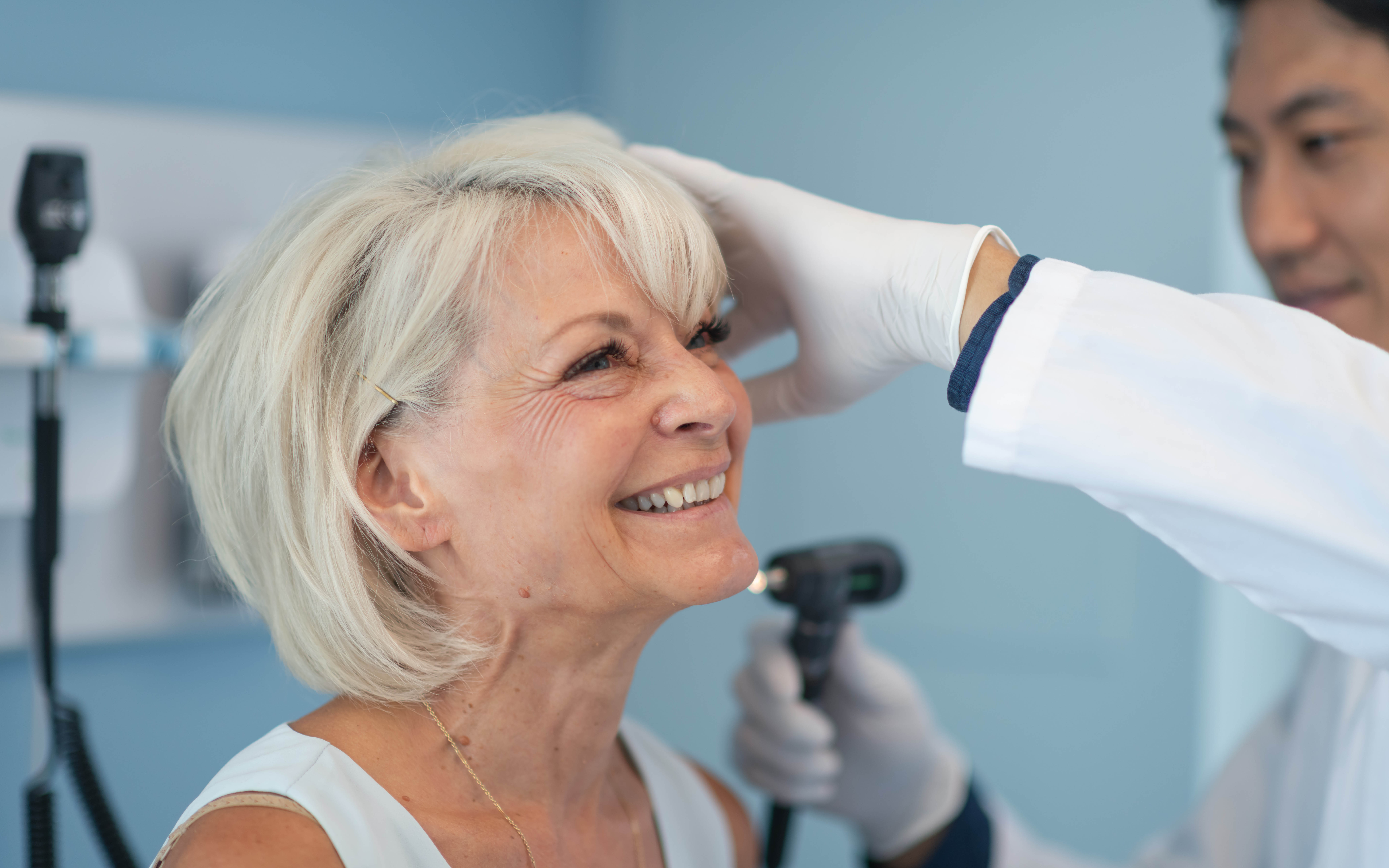Types of hearing loss explained, plus test and treatment advice
Understanding the different types of hearing loss is essential in reducing your risk - here's everything you need to know...


Sadly, hearing loss is a reality for an increasing number of people. According to the Hearing Loss Association of America (HLAA), 48 million Americans - around 20% of the population - suffer from hearing loss, making it the third most prevalent health condition in adults.
Meanwhile, the RNID (formerly Action on Hearing Loss) states that there are now 11 million people living with reduced hearing in the UK – around one-sixth of the population. And by 2035, this is expected to soar to 15.6 million.
- How to reduce your risk of hearing loss: six expert tips
- Menopausal weight gain: everything you need to know
- How to lower cholesterol: tips for a healthy heart
It’s not just a condition confined to old age, either. Hearing problems are already more common once we hit middle age, with 40% of over-fifties experiencing some level of age-related hearing loss. Even more worryingly, the World Health Organization (WHO) has revealed that millennials are most at risk, and are more likely to lose their hearing long before their parents. Indeed, the HLAA states that one in five US teens experience some degree of hearing loss.
Like smoking, hearing damage isn’t obvious and the effect is cumulative – you usually only notice it once the damage has been done and there’s rarely a fix. So understanding the types of hearing loss and their causes is essential.
There are three types of hearing loss:
- Sensorineural hearing loss: caused by damage to the cochlea (inner ear) or auditory nerve
- Conductive hearing loss: when sound is prevented from reaching the cochlea, usually due to a blockage
- Mixed hearing loss: a combination of both sensorineural hearing loss and conductive hearing loss
Sensorineural hearing loss: causes
Presbycusis
Sensorineural deafness is caused by cochlear or nerve damage, and is often age-related (presbyacusis).
Get the Fit&Well Newsletter
Start your week with achievable workout ideas, health tips and wellbeing advice in your inbox.
‘Age-related hearing loss is a natural part of the ageing process,’ says Hidden Hearing clinical audiologist Farhait Kiani. ‘As we get older the hair cells in the inner ear become damaged or die due to wear and tear, and they don’t grow back.’ This can cause presbycusis – a common hearing-loss condition.
You may start to notice that people are ‘mumbling’ or you can’t distinguish words when there’s a lot of background loud noise. ‘Hearing loss tends to be significantly more at higher frequencies as you age, so you may have trouble understanding female voices, more than male ones,’ explains Farhait.
Exposure to loud noise
This is a common cause of hearing loss for people whose job involved exposure to loud noise. However, listening to music with earphones, going to loud concerts and even everyday sounds such as road noise, can harm hearing when exposed to them repeatedly.
Specsavers’ chief audiologist Gordon Harrison advises using ear protection, especially if the noise is 85+ decibels (dB). The higher the volume, the less time you should be exposed to it.
As a guide, WHO has revealed the decibel level of various sounds, and how you long you can listen safely:
- Jet engine = 130 dB (less than 1 second)
- Rock concert = 115 dB (28 seconds)
- Hairdryer = 100 dB (15 minutes)
- Lawnmower = 90 dB (2.5 hours)
- Car traffic = 85 dB (eight hours)
- Washing machine = 70dB (unlimited)
Other causes
Sensorineural hearing loss can also be caused by viruses, head injuries, some medicines, genetic disorders and, occasionally, tumours.
Conductive hearing loss: causes
Ear canal blockages
Hearing works by sound entering our ear canal and striking the eardrum, sending vibrations across three tiny bones (ossicles) in the middle ear to the inner ear (cochlea). This contains fluid and tiny ‘hairs’ that turn sound into electrical signals, which travel along the auditory nerve to the brain where the sound is interpreted. Blocks along this pathway can cause conductive deafness
Common causes of such blockages include:
Earwax: Earwax traps dirt and bacteria, preventing them from entering and causing infections or irritation. However, a build-up of earwax can cause hearing loss, along with earache, infections and vertigo.
Ear infections: These can become more common post-40, as the ear canal becomes thinner and drier, and is more prone to itching. Scratching it then allows the infection in.
‘An infection in the middle ear can cause fluid to build up, obstructing the movement of the eardrum and the tiny bones attached to it, referred to as conductive hearing loss,’ says Farhait. But this is usually temporary and subsides after treatment, which can include antibiotics.
Barotrauma
Conductive hearing loss can be caused by damage to the tympanic membrane (eardrum). This may be caused by rapid changes in air pressure, such as flying, however a common cause is cotton buds being inserted too far into the ear canal. Experts recommend that you never insert anything bigger than your elbow into your ear.
Otosclerosis
A condition that affects the ossicles, the three tiny bones that send sound vibrations from the eardrum in the middle ear to the inner ear.
Hearing loss tests
Online hearing tests can help you determine whether you should have cause for concern from the comfort of your own home. You'll typically need just a pair of headphones and a quiet spot to take the test. Free online hearing checks are offered by the likes of Olive Union and Resound in the US, and Boots and Hidden Hearing in the UK.
However, if you are concerned about your hearing then you should consult a healthcare professional - especially if hearing loss comes on suddenly. Options include your primary health provider, otolaryngologist, audiologist or hearing instrument specialist.
Conductive hearing loss due to wax build-up can usually be treated easily with ear drops. For more complex hearing loss issues, you may be referred to a specialist (as an emergency if deafness comes on suddenly). You’ll need a thorough ear, nose and throat examination and hearing tests (audiometry, tympanometry and tests for electrical signals) to see whether you have conductive or sensorineural deafness or both.
If deafness starts prematurely, or there’s an imbalance between right and left ears, you may also need an MRI scan of your brain and ear canal.
As a matter of course, those aged 55+ should have their hearing checked every two years, as most hearing loss appears gradually.
‘The audiologist will run through your medical history and check the health of your eardrums and ear canal,’ explains Gordon. You’ll don headphones to assess the range of pitches you can hear.

Hearing loss treatment
Hearing aids
You may need specific treatment (such as surgery), but you’re more likely to benefit from a hearing aid – though unfortunately, only one in three of us who needs them actually uses them. However they can make a huge difference and many modern designs are much more effective, advanced and - crucially - discreet - than they used to be, although they may take some getting used to.
‘It may feel strange at first,’ says Gordon. ‘But even standard versions are individually made to fit your ear. Plus, there are discreet wireless options available too.’
Personal sound amplification products (PSAPs)
For many, PSAPs can be an easy starting point in addressing hearing issues - particularly those with low-level hearing loss. These devises do not need to be professionally fitted and can offer a cheaper, more accessible alternative to hearing aids.
A 2019 clinical study found that PSAPs performed as well and basic and premium hearing aids for speech perception, sound quality, listening effort, and user preference in those with mild to moderate hearing loss.
Cochlear implants
If a hearing aid won’t help, children (and some adults) may be offered a cochlear implant. They bypass the damaged part of the ear and stimulate the auditory nerve directly. This enhances the clarity of sounds and improves your ability to understand speech.
Dr Melanie Wynne-Jones has been a GP for over thirty years. She was also Woman’s Weekly Dr Mel for 13 years, and well understands the challenges of trying to maintain a healthy lifestyle whilst combining work with bringing up a family. She was the senior partner in her Cheshire practice for ten years before retiring, and has a wide range of medical interests and expertise. As well as caring for patients, she has spent many years teaching medical students and doctors training to be GPs, and has written extensively for a range of medical publications. She believes that good patient-doctor communication and evidence-based medicine are vital in helping people understand their bodies, and make informed decisions about their lifestyles, medical problems and healthcare. She was awarded Fellowship of the Royal College of General Practitioners in recognition of her clinical, teaching and writing skills, including for her work as Dr Mel.
-
 A Pilates instructor says this is the beginner-friendly core exercise everyone should try
A Pilates instructor says this is the beginner-friendly core exercise everyone should tryForget crunches, this is the perfect foundation move
By Alice Porter Published
-
 Prevent poor posture and release tension from sitting down with these four simple stretches from a yoga instructor
Prevent poor posture and release tension from sitting down with these four simple stretches from a yoga instructorThe daily poses he swears by, no matter what
By Alice Porter Published